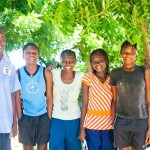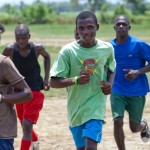Enigma of Beauty
- In 2011, I travelled to Haiti to work with youth involved with G.O.A.L.S. Haiti, an organization that works in Destra, a rural fishing village near Leogane, the epicenter of the earthquake
- Haitians like Emilio and foreign workers like Kona, both of G.O.A.L.S. Haiti in Leogane, work tirelessly to ensure the maximum amount of students receive opportunities to attend school.
- Some GOALS students take advantage of a scholarship program provided by GOALS Haiti and initially funded by my efforts after my initial photo voice workshops.
- Many communities in Haiti survive off of subsistence fishing including Destra, one of G.O.A.L.S. main community partners.
- Everyday workers go out to work the sea in a timeless tradition.
- Over 54,000 fishermen in Haiti rely on the ocean for their livelihood, according to the Ministry of Agriculture, which oversees fisheries management
- Donkeys are indispensable to the land, serving as a mode of transportation…
- As well as providing critical agricultural man power in rural communities throughout Haiti
- While certainly not food sufficient, small plots of land are farmed throughout the country. Over 60% of employment is sprouted from local agriculture in Haiti.
- Farmers work tirelessly to produce food for their families and for their markets year round.
- Less than 2% of Haiti is currently forested, which can lead to sever issues. Known as the land of Mountains Beyond Mountains, there is much greenery left throughout the country
- Many small businesses are currently flourishing in Haiti. These two young entrepreneurs started SISA, a company that provides food stuffs such as Honey, Plantain Chips, and Hot Sauce in 2011. They now provide products throughout the country.
- Revisiting his hometown, my father is reunited with one of his father’s congregation members from childhood during a return to Jeremie, a place he hasn’t been to in over 20 years.
- Spiritual life has been an important societal bond since the beginning of the Haitian state.
- Extended family takes a picture after church on New Years. New Years also marks Independence Day in Haiti. Families such as this one sometimes travel from far abroad to spend time back in their home areas.
- Whether rich or poor, extended family is still one of the strongest societal glues in Haiti. After her their mother died, these two were taken in by their aunt who has committed to seeing them through their primary education.
- All the youth I have worked with in Haiti have enjoyed the opportunity to document their lives and their communities.
- A boy taking part in Project Istwa in Jacmel, a 6-day photo-voice inspired workshop, takes a picture of Maroon Man, a national symbol in Haiti
- One of the students taking part in Project Istwa poses for a picture. She is a leader amongst her classmates not only working hard but encouraging the younger students to take their studies seriously.
- Students attending, Centre de Formation St. Jean Bosco school in Haiti. The school caters to students whose families cannot normally pay for school; they are given a formal education as well as given classes in skilled trades.
- Haitians take great pride in preserving their local environment. Despite a lack of national government structure, local communities around Basin Bleu a natural treasure, collect fees and regulate tourists to ensure the upkeep of the area.
- Youth from Martissant, one of most vulnerable communities in Port-au-Prince, diligently work on an art piece at the largest craft fair in the country, Artisanat en Fete. Artists from all over Haiti gathered to display art pieces.
- Stylistic art is produced throughout Haiti primarily for the consumption of tourists. Most commonly known as a “paysage” , or landscape art, here we see a depiction of the common rural scene in Haiti of woman going out into the river to wash their garments
- G.O.A.L.S. builds relationships with communities by using structured soccer environments to engage youth in community-building and education.
The subject of Enigma is Haiti, qualified with narratives shared by its residents.
Although raised in a house rooted in Haitian culture, I was already 19 when I first traveled to my homeland. The stories imparted to me as a child were contradictory. My grandmother shared stories of a compassionate people and scenic land, yet she was unable to counter the images, filled with conflict, malnutrition, deforestation, and death, presented by American mainstream media. These narrow accounts, selected and propagated by media, helped set expectations of what I was to find and helped inform my initial impressions of the island.
My trips to Haiti quickly challenged any myopic view of Haitian life. Seemingly contradictory realities existed in concert. In 2011, I began holding photo-voice workshops with children. I held these workshops to allow children to own their stories and so that I might join them in an honest dialogue.
It took me months of being embedded in communities spanning the breadth of Haitian society, and many hours of conversation with people of all ages, genders, and socioeconomic statuses to understand and capture those aspects of the story so often missing from the mainstream representations of developing countries. Resolving to fix my lens on the beauty that is often lost behind dust, grime, and preconceived notions, I finally began to unravel the enigma.
Once known as the “Pearl of Antilles,” Haiti is now deemed the “poorest country in the Western Hemisphere.” These competing realities were true of its past and even now, are true of its present. When Haiti was the prized possession of European colonial powers, though economically rich, it was spiritually destitute, a site of genocide, and a center for the dehumanization of black slaves. Now post earthquake, as many suffer from brutal poverty, it is still presides over triumphs of human spirit.

























